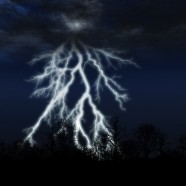
Invented by Benjamin Franklin, lightning rods have been a controversial subject for hundreds of years. Unlike the popular view of them, a lightning rod doesn’t attract lightning to a building. Instead, they simply provide a safe way for electrical energy to reach the ground and avoid damaging a building. The state of Florida offers more lightning strikes per square mile than any other state in the country, so the danger of lightning damage is constant, every day of the year. Preventing damage from a lightning strike by installing a lightning rod system is just smart business.
The Way a Lightning Rod Works
Lightning rods don’t attract lightning, nor do they create it or draw it down from the sky. Lightning will strike in any area it wants, despite anything happening on the ground. When it strikes, lightning can be seen to jump around, moving sideways to find the path of least resistance to the ground. Often the path is a tree, flagpole, house, or other tall object. Whatever is the closest object that will lead low resistance to the ground, that’s where the lightning will strike. When a lightning storm is in the area, there is always a possibility that your business might get hit. With a lightning rod system installed, that hit will conduct the electricity to the ground instead of spreading the energy over your roof and building, causing heat damage or fire.
A Professional Lightning Rod System
A lightning rod is actually a very simple system, and one that can be integrated into your commercial building during construction, or retrofitted afterward. It consists of a terminal, that sits on top of a building, along with a wire that leads from the terminal to the ground, and a buried ground pad where the lightning will eventually end. Air terminals today can be as simple as 18-inch rods not much thicker than a pencil, or even a decorative finial set on the roof and integrated into the safety design. A licensed electrical contractor will be able to inspect a commercial building and advise the size of the lightning rod system that should be installed. A building may need one or many terminals, depending on the size and height of the building, as well as its architectural design.
The Benefits of a Lightning Rod System
The obvious first benefit to having a commercial lightning rod system installed is diverting lightning away from a building and into the ground, avoiding electrical damage and fires. Beyond this, commercial electrical contractors advise installing a lightning rod system for other reasons:
- It can save lives. Dozens of people die from lightning strikes each year, and a surprising number of them are inside buildings when they are hit
- It can save your data. Even if you have no heat damage or fire, a lightning strike right to your building can wipe out your computer system, your POS system, and any other expensive electrical equipment you may run in your business, losing any data stored in their memory
- It can save money. Most insurance companies will offer discounts on a commercial insurance package if a lightning rod system is installed, especially in areas with a high incidence of lightning damage such as Florida
When to Get a Lightning Rod System Installed
A licensed commercial electrical contractor can install a lightning rod system at any stage in the construction process, including retrofitting one years after a building is completed. The best method is to incorporate the lightning rod system into the original electrical wiring design for the building. An integrated system can be more attractive, and can be more easily installed if done so during all the other electrical work in new construction. Your commercial contractor can also add a lightning rod safety system to your existing commercial building of any size. Lightning rods are appropriate for buildings of any height, not just skyscrapers and the tallest buildings in town. If you’ve ever seen photos of lightning striking the ground in the middle of a circle of trees, you know it will hit anywhere it wants. If it aims for your building, the smartest idea is to give it somewhere safe to go.

Recent Comments